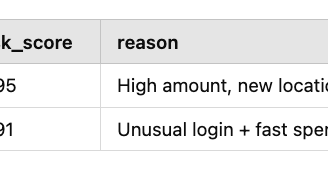Building a Financial Crime Detection Pipeline Using Apache Kafka
Learn how to design and implement a real-time financial crime detection pipeline using Apache Kafka for streaming transaction data. This blog covers core components such as high-throughput ingestion, scalable event processing, anomaly detection logic, and alerting mechanisms tailored for compliance and fraud prevention use cases.
REAL-TIME ANALYTICS & EVENT-DRIVEN ARCHITECTUREUSE CASES & MVP STORIES
Kiran Yenugudhati
2/9/20252 min read
This blog walks through the design of a real-time financial crime detection pipeline using Apache Kafka to ingest, stream, and analyze transaction data.
You’ll learn how to:
Ingest high-velocity transactions using Kafka
Process events in real-time for anomaly detection
Trigger alerts or downstream actions
Build an architecture that supports scalability, compliance, and auditability
🔍 Why Real-Time FinCrime Detection Matters
Traditional batch-based fraud detection systems are:
Too slow to block fraud in progress
Hard to scale under high transaction volumes
Often disconnected from operational systems
A real-time pipeline using Kafka enables you to:
Monitor live transaction streams
Flag suspicious behavior instantly
Reduce financial loss and improve compliance
Enable proactive fraud and AML (anti-money laundering) response
🧰 Core Components
Ingestion : Apache Kafka (transactions topic)
Processing: Spark Structured Streaming / Flink / Databricks
Detection Logic: Rule-based or ML model (fraud scoring)
Storage: Delta Lake / Snowflake / Databricks
Alerting: Kafka topics / REST APIs / Slack / Streamlit
🛠️ Step-by-Step Architecture
1. Real-Time Ingestion with Apache Kafka
Set up Kafka producers to publish raw transaction events in real-time:
Kafka topics:
transactions_raw
flagged_transactions
alerts
2. Stream Processing & Transformation
Use a stream processor (e.g., Spark Structured Streaming, Apache Flink, or Databricks Delta Live Tables) to:
Clean and enrich the data
Join with lookup tables (user risk score, device ID, geo history)
Format events for scoring
🛠️ Streaming pipeline code samples will be added soon.
3. Anomaly Detection Logic
Rule-Based Detection (Simple + Fast)
Multiple failed login + large transaction within 5 mins
New location + unusually high value
Transaction split across multiple cards/accounts
ML-Based Detection (Advanced)
Train fraud detection models using historic labeled data
Score transactions in real-time and flag anything over a threshold
Use features like transaction velocity, geo deviations, network graph signals
🧠 You can run models in Spark, Databricks, or even Snowflake ML in downstream layers.
4. Alerting and Response
Flagged events are written to a new Kafka topic (e.g., alerts_fraud), and pushed to:
Slack / Teams alerts
Email notifications
Internal dashboards (e.g., Streamlit, Grafana, Tableau, Power-BI)
Case management systems
📋 Example Detection Outcome Table
🔐 Compliance, Logging & Governance
Kafka retains the full transaction history (immutable log)
All decisions (rule or ML-based) are logged with timestamps
Supports compliance audits and forensic traceability
Data lineage tracked from ingestion → decision → alert
🎯 Key Benefits
✅ Near real-time detection of suspicious activity
✅ Modular: rules or ML models can evolve independently
✅ Scalable: Kafka handles high volume from banking or ecommerce apps
✅ Auditable: logs and triggers are fully trackable
✅ Integrates easily with fraud teams, dashboards, or case systems
📌 Conclusion
Building a real-time financial crime detection system is no longer reserved for banks with massive engineering teams. With tools like Apache Kafka, stream processors, and modern data platforms, you can:
Detect fraud as it happens
Respond quickly to minimize damage
Stay compliant with AML and reporting regulations
Empower fraud teams with live insights and alerts
📎 Artefacts
Sample Kafka producer/consumer scripts
Detection rules template (SQL + Spark)
Architecture diagram
Streamlit UI for fraud investigation
GitHub starter project


ACTUVATE PTY LTD
Delivering strategic data architecture, cloud engineering, and AI-driven solutions
Connect
Insights
contact@actuvate.com.au
© 2024. All rights reserved.
